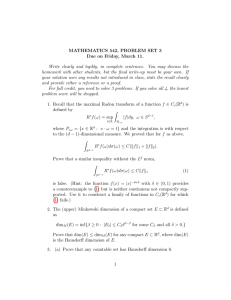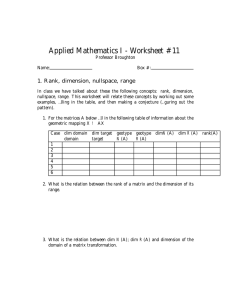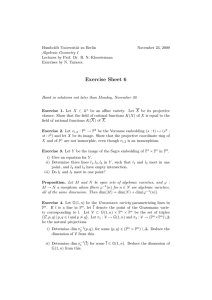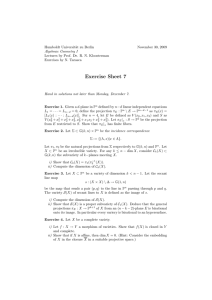Packing Dimension, Hausdorff Dimension and Cartesian Product Sets ∗
advertisement
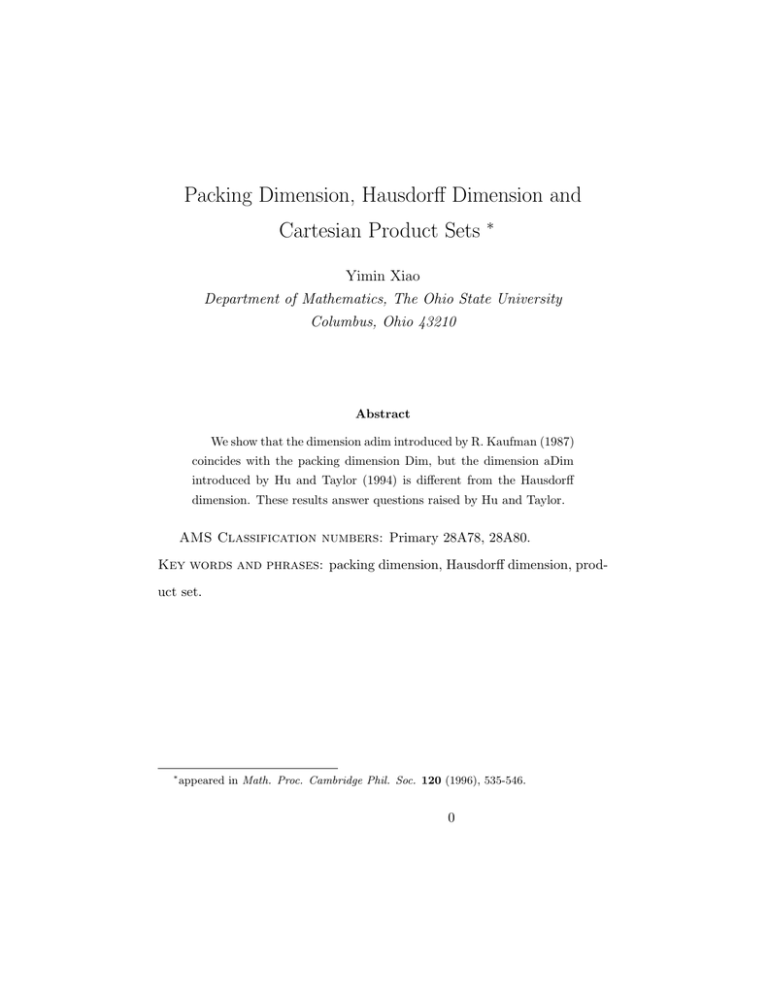
Packing Dimension, Hausdorff Dimension and
Cartesian Product Sets
∗
Yimin Xiao
Department of Mathematics, The Ohio State University
Columbus, Ohio 43210
Abstract
We show that the dimension adim introduced by R. Kaufman (1987)
coincides with the packing dimension Dim, but the dimension aDim
introduced by Hu and Taylor (1994) is different from the Hausdorff
dimension. These results answer questions raised by Hu and Taylor.
AMS Classification numbers: Primary 28A78, 28A80.
Key words and phrases: packing dimension, Hausdorff dimension, product set.
∗
appeared in Math. Proc. Cambridge Phil. Soc. 120 (1996), 535-546.
0
1
Introduction
Hausdorff dimension and packing dimension are two of the most important
fractal dimensions used in analyzing fractal sets ( see [3] [13] [14] [15] [16]
[17] and references therein). There has been a lot of interest in studying the
Hausdorff dimension and packing dimension of cartesian product sets (cf.
[1] [2] [10] [15]). In [15], Tricot proved that for any E, F ⊆ RN ,
dimE + dimF ≤ dim(E × F ) ≤ dimE + DimF
≤ Dim(E × F ) ≤ DimE + DimF ,
(1.1)
where dimE and DimE are the Hausdorff dimension and the packing dimension of E respectively. By using (1.1), Kaufman ([9]) introduced a dimension
adim defined by
adimE = sup{dim(E × F ) − dimF , F ∈ B(R)} ,
where B(R) is the Borel σ-algebra in R. Similarly, Hu and Taylor ([7])
defined another dimension aDim by
aDimE = inf{Dim(E × F ) − DimF , F ∈ B(R)}.
Clearly,
dimE ≤ adimE ≤ DimE,
dimE ≤ aDimE ≤ DimE.
Hu and Taylor ([7]) asked whether for E ⊆ R the followings are true:
adimE = DimE,
(1.2)
aDimE = dimE.
(1.3)
The objective of this paper is to answer these questions. In section 3, We
prove that for every Borel set E ⊆ R, (1.2) holds. Section 4 deals with
aDim. Theorem 4.1 proves the following result which strengthens the third
inequality in (1.1): for any compact set E ⊆ R and any Borel (or analytic)
set F ⊆ R,
b
δ(E)
+ DimF ≤ Dim(E × F ) .
(1.4)
b
where δ(E)
is the modified lower box-counting dimension of E (cf. [3] [15]).
b
Inequality (1.4) implies that for every compact set E ⊆ R, aDimE ≥ δ(E).
1
b
Therefore, for any compact set E with dimE < δ(E)
(see [15] for an ex-
ample), (1.3) does not hold. Theorem 4.2 proves that for any bounded set
E ⊆ R,
aDimE ≤ δ(E) .
and we give an example showing that the strict inequality can hold.
2
Preliminaries
First we recall briefly the definitions of Hausdorff dimension, packing dimension and modified box-counting dimension. Let Φ be the class of functions
φ : (0, δ) → (0, 1) which are right continuous, monotone increasing with
φ(0+) = 0 and such that there exists a finite constant K > 0 for which
φ(2s)
≤ K,
φ(s)
1
for 0 < s < δ .
2
For φ ∈ Φ, E ⊆ RN , the φ-Hausdorff measure of E is defined by
X
φ-m(E) = lim inf{
²→0
φ(2ri ) , E ⊆ ∪i B(xi , ri ) , ri ≤ ²} ,
i
where B(x, r) denotes the open ball of radius r centered at x. It is known that
φ-m is a metric outer measure , and so every Borel set is φ-m measurable
(see [11] for a proof). If φ(s) = sα , then sα -m(E) is called the α-dimensional
Hausdorff measure of E. The Hausdorff dimension of E is defined by
dimE = inf{α > 0 : sα -m(E) = 0}
= sup{α > 0 : sα -m(E) = +∞} .
For more properties of Hausdorff measure and Hausdorff dimension, we refer
to [3].
In [16], Taylor and Tricot defined the set function φ-P (E) on RN by
φ-P (E) = lim sup{
X
²→0
φ(2ri ) : B(xi , ri ) are disjoint, xi ∈ E, ri < ²} .
i
φ-P is not an outer measure because it fails to be countably subadditive.
However, φ-P is a premeasure, so one can obtain a metric outer measure
φ-p on RN by defining
X
φ-p(E) = inf{
φ-P (En ) : E ⊆ ∪n En } .
n
2
φ-p(E) is called the φ-packing measure of E. If φ(s) = sα , then sα -p(E)
is sometimes called the α-dimensional packing measure of E. The packing
dimension of E is defined by
DimE = inf{α > 0 : sα -p(E) = 0}
= sup{α > 0 : sα -p(E) = +∞} .
For any ² > 0 and any bounded set E ⊆ RN , let
N1 (E, ²) = smallest number of balls of radius ² needed to cover E
and
N2 (E, ²) = largest number of disjoint balls of radius ² with centers in E .
Then we have
1
N2 (E, ²) ≤ N1 (E, ²) ≤ N2 (E, ²) .
2
To simplify the notations, we write N (E, ²) for N1 (E, ²) or N2 (E, ²) and
define
∆(E) = lim sup
²→0
δ(E) = lim inf
²→0
log N (E, ²)
,
− log ²
log N (E, ²)
.
− log ²
(2.1)
(2.2)
∆(E) and δ(E) are called the upper and lower box-counting dimension of
E ([3]) or the upper and lower entropy index of E (cf. [14]). The indices ∆
b and
and δ are not σ-stable (cf. [15] [3]). We can obtain σ-stable indices ∆
δb by letting
b
∆(E)
= inf{sup ∆(En ) : E ⊆ ∪n En } ,
(2.3)
b
δ(E)
= inf{sup δ(En ) : E ⊆ ∪n En } .
(2.4)
b
b
According to [3], we call ∆(E)
and δ(E)
the modified upper box-counting
dimension of E and the modified lower box-counting dimension of E respecb
b
tively. It is easy to see that dimE ≤ δ(E) and δ(E)
≤ ∆(E)
. In [15], Tricot
b
proved that DimE = ∆(E).
Hence, for any set E ⊆ RN ,
b
b
0 ≤ dimE ≤ δ(E)
≤ ∆(E)
= DimE ≤ N .
(see [13] for another proof of dimE ≤ DimE ).
3
Let µ be a Borel measure on RN . For any φ ∈ Φ and any x ∈ RN , the
upper and lower φ-densities of µ at x are defined by
Dµ (x) = lim sup
µ(B(x, r) ∩ E)
,
φ(2r)
Dφµ (x) = lim inf
µ(B(x, r) ∩ E)
.
φ(2r)
φ
r→0
r→0
φ
α
If φ(s) = sα , then we write Dµ and Dφµ as Dµ and Dαµ respectively.
The following lemma is a special case of the density theorems for Hausdorff measure and packing measure (see [12] [13] [16]).
Lemma 2.1 Let µ be a probability Borel measure on RN . Consider E ⊆
RN with µ(E) > 0.
(i) If there exists a constant c1 > 0 such that
α
sup Dµ (x) ≤ c1 ,
x∈E
then dimE ≥ α.
(ii) If there exists a constant c2 > 0 such that
sup Dαµ (x) ≤ c2 ,
x∈E
then DimE ≥ α.
Lemma 2.2
For any sets E, F ⊆ RN ,
dimE + dimF ≤ dim(E × F ) ≤ dimE + DimF
≤ Dim(E × F ) ≤ DimE + DimF.
Remark. The first inequality was proved by Marstrand ([10]) for any
E, F ⊆ R and was studied earlier by Besicovitch and Moran ([1]) and
Eggleston ([2]) under some extra hypothesis on E and F. The inequalities
involving Dim were first proved by Tricot ([15]). The proof of the third
inequality given in [15] is insufficient. But it can be proved for any Borel
(or analytic) sets E and F by using Lemma 2.1 or a result of Haase ([5]).
For a proof of the general (non-analytic) case, see [6].
The following lemma is proved in [4] (see also [8]).
4
Lemma 2.3 Let E ⊆ RN be any analytic set. Then for any γ < DimE,
there exists a compact set K such that K ⊆ E and DimK > γ.
Recall from [15] that ∆ is uniform on E means that there exists a constant c such that for any x ∈ E ,
lim ∆(E ∩ B(x, r)) = c .
r→0
Lemma 2.4 is proved in [15] (see also [3] Lemma 3.6).
Lemma 2.4 If E is compact and ∆ is uniform on E, then ∆(E) = DimE.
More generally, if ∆(E ∩ U ) ≥ γ for every open ste U that intersects E,
then DimE ≥ γ .
3
Packing dimension and Cartesian product sets
In [9], Kaufman introduced the dimension adim by using the Hausdorff
dimension of cartesian product sets,
adimE = sup{dim(E × F ) − dimF, F ∈ B(R)}.
Clearly dimE ≤ adimE ≤ DimE. Hu and Taylor ([7]) asked whether for any
set E ⊆ R,
adimE = DimE .
(3.1)
In this section, we prove that, for every Borel set E ⊆ R, (3.1) holds.
A compact set Eγ is called a Cantor-type set if Eγ = ∩∞
n=1 En , where
Ni
1
0
En = ∪N
i1 =1 · · · ∪in =1
···in−1
Ii1 ···in
(n = 1, 2, · · · )
is a decreasing sequence of compact sets and for each n ≥ 1, Ii1 ···in (in =
1, · · · , Ni1 ···in−1 ) are disjoint closed subintervals of Ii1 ···in−1 .
Lemma 3.1 Let E ⊆ R be compact. For any γ < DimE, there exists
a Cantor-type set Eγ = ∩∞
n=1 En with Eγ ⊆ E and satisfies the following
properties
0
(i) E1 = ∪N
i1 =1 Ii1 , where
·
¸
1
N0 = γ + 1
η0
1 1
(0 < η0 < ( ) γ ) ,
2
5
(3.2)
[x] is the integer part of x , and {Ii1 } (i1 = 1, · · · , N0 ) are closed
intervals of length 2δ0 ≤ 12 η0 with gap between any two of them greater
than η0 .
Ni
1
0
(ii) For n ≥ 2, En = ∪N
i1 =1 · · · ∪in =1
···in−1
·
Ni1 ···in−1 =
Ii1 ···in , where
1
¸
ηiγ1 ···in−1
+1 ,
(3.3)
1
|Ii1 ···in | = 2δi1 ···in−1 ≤ ηi1 ···in−1 .
2
Each interval Ii1 ···in−1 of En−1 contains Ni1 ···in−1 closed subintervals
Ii1 ···in (in = 1, 2, · · · ,
Ni1 ···in−1 ) with gaps greater than ηi1 ···in−1 .
(iii) There exists a Borel probability measure σ on R with σ(Eγ ) = 1 such
that, for each interval Ii1 (i1 = 1, · · · , N0 ),
σ(Ii1 ) = N0−1 ,
and for each interval Ii1 ···in in En ,
σ(Ii1 ···in ) = σ(Ii1 ···in−1 )Ni−1
.
1 ···in−1
(3.4)
(iv) For every open set V ⊆ R that intersects Eγ , we have Dim(Eγ ∩ V ) ≥
γ.
Proof. (i) - (iii) were proved in [18]. We include the main steps of the
proof for the convenience of readers. Fix γ < γ 0 < DimE and let
F = {I : I is a rational closed interval with Dim(I ∩ E) ≤ γ 0 }.
Then F is countable and by the σ-stability of Dim, we have
DimF = DimE,
where F = E\ ∪I∈F I. Observe that for any x ∈ F and for any r > 0,
Dim(F ∩ [x − r, x + r]) > γ 0 .
(3.5)
1
Since ∆(F ) ≥ DimF > γ 0 , there exists an 0 < η0 < ( 12 ) γ such that
N (F, η0 ) > (
1 γ
) .
η0
6
Let x1 , · · · , xN0 be N0 = [( η10 )γ ] + 1 points in F with |xj − xk | ≥ 2η0 for
j 6= k. If we choose δ0 < 14 η0 , then the intervals Ii1 = [xi1 − δ0 , xi1 + δ0 ] (i1 =
1, · · · , N0 ) are disjoint and by (3.5)
Dim(F ∩ Ii1 ) > γ 0 for every 1 ≤ i1 ≤ N0 .
(3.6)
0
Let E1 = ∪N
i1 =1 Ii1 ; then (ii) can be proved by using (3.6) and induction, (iii)
follows from the mass distribution principle (see [3]) and (iv) follows from
Lemma 2.4. 2
Remark. By the construction of Eγ , once ηi1 ···in−1 has been chosen, we
can choose ηi1 ···in−1 in as small as we please. In particular, we can choose η’s
satisfying
ηi1 ···in−1
ηi1−γ
1 ···in−1 in
≥n+1 .
(3.7)
Now we prove the main result of this section.
Theorem 3.1 Let E ⊆ R be a Borel set. Then
DimE = sup{dim(E × F ) − dimF, F ∈ B(R)}.
Proof. By Lemma 2.2, it is clear that
DimE ≥ sup{dim(E × F ) − dimF, F ∈ B(R)} .
To prove the reverse inequality, it is sufficient to show that for any γ <
DimE, there exists a set F ⊆ [0, 1] such that
dimF ≤ 1 − γ,
(3.8)
dim(E × F ) ≥ 1.
(3.9)
By Lemma 2.3, we can and will assume that E ⊆ R is compact. Fix a
γ < DimE, let Eγ be the Cantor-type set in Lemma 3.1 with η’s satisfying
(3.7) and let σ be the Borel probability measure in Lemma 3.1 (iii). Now
we construct a decreasing sequence of closed subsets Fn ⊆ [0, 1] inductively
and then define F = ∩∞
n=1 Fn . Naturally, the construction of {Fn } depends
on the structure of {En }. To simplify the notations, from now on, we will
not distinguish a positive number from its integer part.
The basic principle for the construction of Fn is, for each Ii1 ···in−1 in
En−1 , we construct Fn,i1 ···in−1 and then let Fn to be the union of them. In
this way, we can make dim(E × F ) large and keep dimF small.
7
For n = 1, let
b1 =
1
,
η0 1−γ
(3.10)
where η0 is the constant in (3.2), and let F1 = ∪bj11=1 Jj1 , where Jj1 (j1 =
1, · · · , b1 ) are closed subintervals of [0, 1] of length η0 with gaps at least η̃0
and
1
η˜0 ≈ η01−γ ,
2
1
where a ≈ b means 2 b ≤ a ≤ b. F1 is well defined since
b1 (η˜0 + η0 ) ≤
1
+ η0γ < 1.
2
By (3.10), we have
b1
X
|Jj1 |1−γ = 1.
j1 =1
Ni
0
1
For n = 2, by Lemma 3.1 (ii), E2 = ∪N
i1 =1 ∪i2 =1 Ii1 i2 . In order to construct
0
F2 , we construct F2,i1 for i1 = 1, · · · , N0 , and then define F2 = ∪N
i1 =1 F2,i1 .
For each fixed i1 , to construct F2,i1 , let
b2,i1 =
η0
ηi1 1−γ
.
(i )
In each interval Jj1 of F1 , we construct b2,i1 closed subintervals Jj11j2 of length
ηi1 with gaps at least η̃i1 and
1
.
η̃i1 ≈ ηi1−γ
2 1
This is possible since
1
b2,i1 (η̃i1 + ηi1 ) ≤ ( + ηiγ1 ) · η0 < η0 .
2
We set
b2,i
(i )
1
F2,i1 = ∪bj11=1 ∪j2 =1
Jj11j2
and
0
F2 = ∪N
i1 =1 F2,i1 .
Then
2,i1
N0 X
b1 bX
X
i1 =1 j1 =1 j2 =1
|
(i )
Jj11j2 |1−γ
=
N0
X
i1 =1
=
=
N0
X
b1 b2,i1 ηi1−γ
1
1
1−γ
i1 =1 η0
1.
8
·
η0
1−γ
ηi1
· ηi1−γ
1
Suppose now that
Ni
1
n−3
0
Fn−1 = ∪N
Fn−1,i1 ···in−2
i1 =1 · · · ∪in−2 =1
···i
has been constructed with
bn−1,i
1
Fn−1,i1 ···in−2 = ∪bj11=1 · · · ∪jn−1 =1
(i ···i
···in−2
(i ···i
)
n−2
Jj11···jn−1
,
)
n−2
where |Jj11···jn−1
| = ηi1 ···in−2 , and
N0
X
Ni1 ···in−3
X
···
i1 =1
in−2 =1
= 1.
b1 b2,i1 · · · bn−1,i1 ···in−2 · ηi1−γ
1 ···in−2
(3.11)
We will construct Fn in the same way as that for n = 2. By Lemma 3.1 (ii),
Ni
1
0
En = ∪N
i1 =1 · · · ∪in =1
···in−1
Ii1 ···in .
For each fixed i1 · · · in−1 , we define
bn,i1 ···in−1 =
(i ···i
ηi1 ···in−2
ηi1−γ
1 ···in−1
.
(3.12)
)
n−2
In each interval Jj11···jn−1
of Fn−1,i1 ···in−2 , we construct bn,i1 ···in−1 closed
(i ···i
)
subintervals Jj11···jnn−1 of length ηi1 ···in−1 and gaps at least η̃i1 ···in−1 with
1
η̃i1 ···in−1 ≈ ηi1−γ
.
2 1 ···in−1
(3.13)
This is possible since
1
bn,i1 ···in−1 (η̃i1 ···in−1 + ηi1 ···in−1 ) ≤ ( + ηiγ1 ···in−1 ) · ηi1 ···in−2
2
< ηi1 ···in−2 .
(i ···i
)
Let Fn,i1 ···in−1 be the union of all the intervals Jj11···jnn−1 ,
bn,i
b2,i
1
1
Fn,i1 ···in−1 = ∪bj11=1 ∪j2 =1
· · · ∪jn =1
···in−1
(i ···i
)
Jj11···jnn−1 .
As i1 · · · in−1 varies, we obtain a sequence {Fn,i1 ···in−1 } of compact sets. Let
Ni
1
n−2
0
Fn = ∪N
Fn,i1 ···in−1 .
i1 =1 · · · ∪in−1 =1
···i
Then by (3.11) and (3.12), we have
Ni1 ···in−2
N0
X
···
i1 =1
=
X
i1
···
X
in−1 =1
X
in−2
b1 b2,i1 · · · bn,i1 ···in−1 · ηi1−γ
1 ···in−1
b1 b2,i1 · · · bn−1,i1 ···in−2 · ηi1−γ
1 ···in−2
= 1.
(3.14)
9
By induction, we have constructed a decreasing sequence of closed sets {Fn }
satisfying (3.13) and (3.14). Set F = ∩∞
n=1 Fn ; then F ⊆ [0, 1] is a compact
set.
Now we verify that F satisfies (3.8) and (3.9). Since for each n ≥ 1, F ⊆
Fn , equation (3.14) implies that
dimF ≤ 1 − γ.
This proves (3.8). To prove (3.9), we observe that for each n ≥ 1, En × Fn ⊇
Gn , where G1 = E1 × F1 and for n ≥ 2,
Ni
1
0
Gn = ∪N
i1 =1 · · · ∪in =1
···in−1
bn,i
b2,i
1
1
∪bj11=1 ∪j2 =1
· · · ∪jn =1
···in−1
(i ···i
)
Ii1 ···in × Jj11···jnn−1 .
Let G = ∩∞
n=1 Gn ; then G is compact and G ⊆ Eγ × F. So it is sufficient to
prove that
dimG ≥ 1.
(3.15)
To this end, we first define a Borel measure µ on R2 with µ(G) = 1 and
then use Lemma 2.1 to prove (3.15). For each rectangle Ii1 × Jj1 in G1 , we
define
µ(Ii1 × Jj1 ) =
σ(Ii1 )
= η0 .
b1
(i )
For each rectangle Ii1 i2 × Jj11j2 in G2 , we define
(i )
µ(Ii1 i2 × Jj11j2 ) =
σ(Ii1 i2 )
b1 b2,i1
= (η0 ηi1 )γ · η0−γ ηi1−γ
1
= ηi1 .
(i ···i
)
Similarly, for each rectangle Ii1 ···in × Jj11···jnn−1 in Gn , we define
(i ···i
)
σ(Ii1 ···in )
b1 b2,i1 · · · bn,i1 ···in−1
= ηi1 ···in−1 .
µ(Ii1 ···in × Jj11···jnn−1 ) =
(3.16)
Finally, for each n ≥ 1, we define µ(R2 \Gn ) = 0. Then µ can be extended
to a Borel measure on R2 with µ(G) = 1.
For any x ∈ G, there exist two sequences i = i1 i2 · · · in · · · and j =
j1 j2 · · · jn · · · , such that
(i ···i
)
1
n−1
{x} = ∩∞
.
n=1 Ii1 ···in × Jj1 ···jn
10
For any r > 0, there exists an n such that
ηi1 ···in−1 ≤ r < ηi1 ···in−2 .
Consider first the case ηi1 ···in−1 ≤ r < η̃i1 ···in−1 . Since the gaps between any
two of Ii1 ···in are at least ηi1 ···in−1 , B(x, r) can intersect at most
(i ···i
)
r
ηi1 ···in−1
rectangles Ii1 ···in × Jj11···jnn−1 , so by (3.16), we have
(i ···i
r
)
µ(B(x, r)) ≤ µ(Ii1 ···in × Jj11···jnn−1 ) ·
ηi1 ···in−1
= r.
(3.17)
Consider the second case η̃i1 ···in−1 ≤ r < ηi1 ···in−2 . Since the gaps between
(i ···i
)
any two intervals Jj11···jnn−1 are at least η̃i1 ···in−1 , then B(x, r) can intersect
at most
r
η̃i1 ···in−1
(i ···i
)
rectangles Ii1 ···in × Jj11···jnn−1 . So by (3.13) and
· ηi−γ
1 ···in−1
(3.16), we have
µ(B(x, r)) ≤
r
η̃i1 ···in−1
≤ 4r .
(i ···i
)
· ηi−γ
· µ(Ii1 ···in × Jj11···jnn−1 )
1 ···in−1
(3.18)
Combining (3.17) and (3.18), we have that for any x ∈ G,
lim sup
r→0
µ(B(x, r))
≤ 2.
2r
Hence by Lemma 2.1, we have dimG ≥ 1. This proves (3.15) and hence
Theorem 3.1. 2
Remark. In (1.1), by taking F to be any set with dimF = DimF, we
obtain that, for any Borel set E ⊆ R,
DimE = sup{ Dim(E × F ) − DimF ,
dimE = inf{ dim(E × F ) − dimF ,
4
F ⊆ R} ,
F ⊆ R} .
The dimension δb and Cartesian product sets
We start with the following theorem which strengthens the third inequality
in (1.1).
Theorem 4.1 Let E ⊆ R be any Borel set and let F ⊆ R be compact.
Then
b ) ≤ Dim(E × F ) .
DimE + δ(F
11
(4.1)
1
b )
Proof. It is sufficient to prove that for any γ < DimE, β < δ(F
Dim(E × F ) ≥ γ + β .
(4.2)
By Lemma 2.3, we can assume that E is compact. Then by Lemma 3.1,
there exists a Cantor-type set Eγ ⊆ E such that Dim(Eγ ∩ V ) ≥ γ for every
open set V that intersects Eγ .
b
For any β < δ(E),
let
½
G=
¾
b ∩ J) ≤ β
J : J is a rational open interval with δ(F
.
b we have
Then G is countable and by the σ-stability of δ,
µ
¶
b
b
δ(F ) = δ F \ ∪J∈G J .
Set Fβ = F \ ∪J∈G J ; then Fβ ⊆ F is compact and for any open set W that
intersects Fβ , we have
b
δ(F
β ∩ W) > β .
(4.3)
For any ² > 0, by (2.3), we may find {Gn } with
Eγ × Fβ ⊆ ∪∞
n=1 Gn ,
and for every n,
∆(Gn ) ≤ Dim(Eγ × Fβ ) + ² ≤ Dim(E × F ) + ² .
(4.4)
Since ∆(Gn ) = ∆(Gn ), we may take Gn to be closed and Gn ∩(Eγ ×Fβ ) 6= ∅ .
By Baire’s category theorem, there exist n and an open set U that intersects
Eγ × Fβ such that U ∩ (Eγ × Fβ ) ⊆ Gn . We may find open sets V, W such
that V × W ⊆ U and V × W intersects Eγ × Fβ , so
(Eγ ∩ V ) × (Fβ ∩ W ) ⊆ Gn .
(4.5)
By (4.3), (4.4) and (4.5), we have
b
γ + β ≤ Dim(Eγ ∩ V ) + δ(F
β ∩ W)
≤ ∆(Eγ ∩ V ) + δ(Fβ ∩ W )
µ
¶
(cf. [15])
≤ ∆ (Eγ ∩ V ) × (Fβ ∩ W )
≤ ∆(Gn )
≤ Dim(E × F ) + ² .
1
This proof of using Baire’s category theorem was kindly suggested to me by the referee.
My previous proof is constructive and is much longer.
12
Since ² > 0 is arbitrary, this proves (4.2) and hence (4.1). 2
Remark. For any Borel(or analytic) set F ⊆ R and compact set E ⊆ R,
we have
b
δ(E)
+ DimF ≤ Dim(E × F ) .
This implies that for any compact set E,
b
δ(E)
≤ aDimE .
b
Therefore, for any compact set E ⊆ R with dimE < δ(E)
(see [15] for an
example), we have dimE < aDimE.
The next theorem gives an upper bound for aDim.
Theorem 4.2 For any bounded set E ⊆ R,
aDimE ≤ δ(E) .
(4.6)
Proof. In order to prove (4.6), we show that for any γ > δ(E), there exists
a Borel set F ⊆ R such that
Dim(E × F ) ≤ 1 ,
(4.7)
DimF ≥ 1 − γ .
(4.8)
Since γ > δ(E), by (2.2), there exists a decreasing sequence of positive
numbers {²n } such that
²γ1 <
1
,
2
µ
²n
¶γ
²n−1
<
1
2
for n ≥ 2 ,
(4.9)
and
1
.
(4.10)
²γn
Now we construct Fn inductively, and then define F = ∩∞
n=1 Fn . For n = 1,
N (E, ²n ) <
let
b1 =
1
²1−γ
1
,
and let F1 = ∪bj11=1 Jj1 , where Jj1 (j1 = 1, 2, · · · , b1 ) are closed subintervals
of [0, 1] of length ²1 . We arrange these intervals so that they are equally
spaced with gaps ²1 and that they are contained in an interval of length
2²γ1 . This is possible since
b1 · 2²1 = 2²γ1 < 1 .
13
Suppose now that Fn−1 has been constructed as a union of
closed intervals Jj1 ···jn−1 with |Jj1 ···jn−1 | = ²n−1 . Let
µ
bn =
²n−1
²n
1
1−γ
²n−1
disjoint
¶1−γ
.
In each interval Jj1 ···jn−1 of Fn−1 , we construct bn closed subintervals Jj1 ···jn
(jn = 1, · · · , bn ) of length ²n in such a way that these intervals are equally
γ
spaced with gaps ²n and they are contained in an interval of length 2²1−γ
n−1 ·²n .
This is possible since by (4.9), we have
γ
bn · 2²n = 2²1−γ
n−1 · ²n
µ
¶γ
²n
· ²n−1
= 2
²n−1
< ²n−1 .
Let Fn be the union of these
1
²1−γ
n
closed intervals Jj1 ···jn ,
Fn = ∪bj11=1 · · · ∪bjnn=1 Jj1 ···jn .
By induction, we have constructed a decreasing sequence of closed sets {Fn }
(n = 1, 2, · · · ). Let F = ∩∞
n=1 Fn ; then F ⊆ [0, 1] is compact.
We observe that for ² = 12 ²n ,
N (F, ²) =
1
²1−γ
n
.
By (2.1), we have
∆(F ) ≥ 1 − γ .
(In fact, we have ∆(F ) = 1 − γ). On the other hand, ∆ is uniform on F.
Therefore by Lemma 2.4, we have
DimF = ∆(F ) ≥ 1 − γ .
1
This proves (4.8). For any 0 < ² < ( 12 ) γ , there exists an n ≥ 1 such that
²n ≤ ² < ²n−1 .
γ
Consider first the case ²n ≤ ² < 2²1−γ
n−1 · ²n . Then by (4.10), we have
N (E × F, ²) ≤ N (E, ²n ) ·
≤
1
²1−γ
n−1
2²1−γ
²γ
· K1 n−1 n
²
2K1
,
²
(4.11)
14
where K1 > 0 is an absolute constant.
γ
Consider the second case 2²1−γ
n−1 · ²n ≤ ² < ²n−1 . Then by (4.10), we have
N (E × F, ²) ≤ N (E, ²n−1 ) · K1
≤
²n−1
1
· 1−γ
²
²n−1
K1
.
²
(4.12)
Combining (4.11) and (4.12), we obtain
∆(E × F ) ≤ 1 .
Therefore Dim(E × F ) ≤ 1. This completes the proof of Theorem 4.2. 2
Remark. The inequality in (4.6) can be strict. For example, let E =
{0,
1
n,
n ≥ 1}; then δ(E) =
1
2
(cf. [3]), but aDimE = 0.
After having obtained the results in this paper, I was informed by Prof.
Falconer and Prof. Taylor that Dr. C. J. Bishop and Dr. Y. Peres also
obtained similar results independently.
Acknowledgement The author would like to thank Prof. Talagrand
for discussions and encouragement. He also thanks Prof. G. Edgar, Prof.
K. J. Falconer, Prof. S. J. Taylor, Dr. Y. Peres and the referee for their
comments which lead to a lot of improvements of the manuscript.
References
[1] Besicovitch, A. S. and Moran, P. A. P., The measure of product and
cylinder sets. J. London Math. Soc. 20 (1945), 110 - 120.
[2] Eggleston, H. G., A correction to a paper on the dimension of Cartesian
product sets. Proc. Camb. Phil. Soc. 49 (1953), 437 - 440.
[3] Falconer, K. J., Fractal Geometry – Mathematical Foundations And
Applications. Wiley & Sons. 1990.
[4] Hasse, H., Non-σ-finite sets for packing measure. Mathematika
33
(1986), 129 - 136.
[5] Haase, H., On the dimension of product measures. Mathematika 37
(1990), 316 - 323.
15
[6] Howroyd, J. D., On the packing dimension of product spaces. To appear
in Math. Proc. Camb. Philo. Soc.
[7] Hu, X. and Taylor, S. J. Fractal properties of products and projections
of measures in Rd . Math. Proc. Camb. Phil. Soc. 115 (1994), 527 544.
[8] Joyce, H. and Preiss, D. On the existence of subsets of finite positive
packing measure. Mathematika 42 (1995) 15 - 24.
[9] Kaufman, R. Entropy, dimension and random sets. Quart. J. Math.
Oxford (2) 38 (1987), 77 - 80.
[10] Marstrand, J. M. The dimension of the Cartesian product sets. Proc.
Camb. Phil. Soc. 50 (1954), 198 - 202.
[11] Rogers, C. A. Hausdorff Measures. Cambridge University Press, 1970.
[12] Rogers, C. A. and Taylor, S. J. Additive set functions in euclidean
space. Acta Math. 101 (1959), 273 - 302.
[13] Saint Raymond, X. and Tricot, C. Packing regularity of sets in n-space.
Math. Proc. Camb. Phil. Soc. 103 (1988), 133 - 145.
[14] Taylor, S. J. The measure theory of random fractals. Math. Proc. Camb.
Phil. Soc. 100 (1986), 383 - 406.
[15] Tricot, C. Two definitions of fractional dimension. Math. Proc. Camb.
Phil. Soc. 91 (1982), 57 - 74.
[16] Taylor, S. J. and Tricot, C. Packing measure and its evalution for a
Brownian path. Trans. Amer. Math. Soc. 288 (1985), 679 - 699.
[17] Taylor, S. J. and Tricot, C. The packing measure of rectifiable subsets
of the plane. Math. Proc. Phil. Soc. 99 (1986), 285 - 296.
[18] Talagrand, M. and Xiao, Yimin. Fractional Brownian motion and packing dimension. 1995.
16
